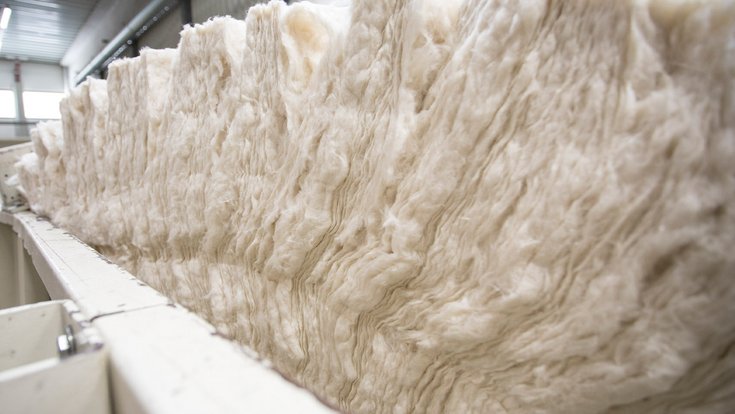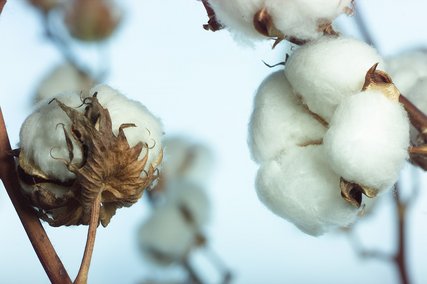

Sustainable by nature
Cotton is the stuff of which the Industrial Revolution was made. And it's the stuff that globally and up to today, is used more than any other fiber. For banknote production, it is nothing less than the raw material of choice when it comes to maximum security, sustainability, and durability. About a raw material that has not only shaped our everyday lives for thousands of years, but that is also becoming better and better through innovation.
Edward Baines, a newspaper editor and Member of Parliament from Leeds, England, could hardly hold his own when it came to cotton. In 1835, he described cotton as a “spectacle, unparalleled in the annals of industry, whether we regard the suddenness of its growth, the magnitude which it has attained, or the wonderful inventions to which its progress is to be ascribed”.
Admittedly, the Industrial Revolution was in full swing and cotton was its fuel. Nevertheless, Baines pretty much sums it up with this euphoric tribute in his “History Of The Cotton Manufacture” almost 200 years ago: the technological achievements associated with cotton, the revolutionary progress that would have been unthinkable without it, its importance for industry, society, the economy, its efficiency. And even today, cotton is so ubiquitous that it is hardly noticed for what it is: one of the great achievements of mankind.
From a very big and broad perspective, however, it is always worth looking into the details, into the depth of what really makes the white cotton balls. It's worth taking a look at a few facts: for example, 100 pairs of jeans, 550 men's T-shirts, 3,000 diapers, or 300,000 cotton balls can be produced from 100 kilograms of cotton, calculates the International Cotton Advisory Committee (ICAC).
Cotton impresses with its sustainable efficiency

And, the ICAC further estimates, a single ton of cotton employs up to six people throughout the year. Moreover, as the newspaper publisher Baines already suspected in the first third of the 19th century, cotton impresses with its efficiency: only three percent of the world's agricultural land is taken up for its production, which, however, covers 27 percent of the global demand for textiles.
Added to this is its sustainability, or to put it another way, its negative carbon footprint: all crops produce greenhouse gases during production, including cotton, which emits 1.7 kilograms of carbon dioxide to produce one kilogram of fiber, mainly caused by the use of fertilizers and pesticides in conventional cultivation. However, in its leaves and soil, it binds 2.2 kilograms of the greenhouse gas, which means that it removes more CO2 from the atmosphere than it emits. "Cotton uses oxygen and CO2 to make cellulose, and since its fibres are 96% to 98% pure cellulose, cotton is the world’s best biodegradable natural fibre, says the ICAC.
In this mix of sustainability, efficiency, durability and global availability, it is hardly surprising that cotton has also found its way into the production of security and banknote papers. More precisely: short-fiber cotton combs. The white cotton balls are picked, then processed in a factory and combed into long yarns. As the cotton balls are combed, small pieces fall off. These small pieces, also called noils or combing waste, are used to produce banknotes – but also technical textiles, security papers, blends for coarse yarn or, in the open-end spinning process, denim.
As far as the concrete figures are concerned, around 24 million tons of cotton are harvested worldwide every year, with around 20 to 30 percent of the cotton combs produced as byproducts during processing – i.e. around six million tons. With an annual requirement of around 125,000 tons of combs, the banknote industry therefore uses just two percent of the “byproduct” of cotton production.
A byproduct that – unlike pulp, for example – is also notable for its durability: among other things, banknotes have to be able to withstand a washing machine cycle without any problems or damage. Let’s be honest: who hasn't experienced the situation when a banknote is pulled out of a trouser pocket after being washed?

An embedded security other substrates cannot achieve
So much for the “raw material side”, which in the case of banknote and security papers must of course never be considered in isolation, but rather in a package with security, durability, and complex production processes: “The production of a fiber-based banknote from cotton is impressive because of its complexity, and the possibility of embedded security features during the individual processing steps at a density that other substrates cannot achieve,” says Astrid Drexler, Product Manager for High-Security Paper, at Louisenthal.
For example, the production of papers with watermarks – proven the security feature best known to the public – requires in-depth detailed knowledge of cylinder mold technology to produce the right, individual mold for each denomination and therefore is still very difficult to counterfeit in good quality. Or the production of a security thread that requires up to 18 process steps before it can be embedded into the cotton note: the “security density” associated with this, Drexler continues, is much higher and safer than elements produced purely by printing or applying on two-dimensional substrates.
In other words: cotton is “three-dimensional”. The raw material offers the option of embedding security elements such as threads into its interior or forming a three-dimensional structure itself, such as watermarks. But: “It needs access to the industry, to technologies and the associated advantages in know-how make up the co-decisive plus in security and trust in the cotton banknotes”, says Drexler.
Cotton is “three-dimensional”. The raw material offers the option of embedding security elements such as threads into its interior or forming a three-dimensional structure itself, such as watermarks.
In addition to the increasing demands for security and efficiency, the call for sustainability in cotton-production and use, banknote production, and the whole cash cycle is becoming ever louder – which at the same time shows that the topic of sustainable cotton has gained in importance, but is also somewhat complex: every single production step brings levers that can improve sustainability – from the raw material itself to the use of energy and the choice of transport means and routes.
For example, in its “2020 update of the ECB's Environmental Statement,” the ECB writes: “The ECB’s Directorate Banknotes together with the Eurosystem NCBs is implementing policies to minimize the environmental impact of the production of euro banknotes.” Policies include increasing the ratio of sustainable cotton in the substrate of the euro notes to 100%: In 2019 approximately 5,210 tons of cotton combers, the main raw material used to produce banknote paper, were used in this process, 57% of which were certified as originating from a sustainable source in environmental and social terms. “The ECB is strongly committed to maintaining and improving the sustainability of euro banknotes by gradually increasing the amount of sustainable cotton in euro banknote paper.”

De Nederlandsche Bank (DNB), among others, agrees with this and already decided in 2007 to use sustainable cotton for the production of banknotes. “Since 2019, all our new banknotes have been made entirely from sustainable cotton. The sustainable cultivation of cotton is more environmentally friendly than traditional methods, in which many chemicals, such as weed killers, are used. And in sustainable cotton cultivation, farmers and cotton pickers get better wages.”
In fact, organic cotton uses non-genetically modified (GMO) seeds and inputs such as pesticides and fertilizers – but only if they are of natural origin. Conventional cotton, on the other hand, may use GMO seeds and pesticides and chemicals that are not themselves organic. In terms of performance, feel and appearance, there is no discernible difference between cotton grown organically or conventionally.
Reads wonderful in theory, in practice standards like the Global Organic Textile Standard (GOTS) guarantee and certify the sustainability not only of the end product but of the entire production process: “In 2006, the first certification according to the GOTS was carried out. Since then, more than 10,000 other companies have joined,” says Juliane Ziegler GOTS Representative in Germany, Austria and Switzerland.
The number speaks for itself and shows that this is no longer just a trend. Compared to “greenwashing” often based on pure self-claims, GOTS guarantees compliance with social and ecological standards through independent certification, from the field to the finished textile. And, says Ziegler, “many companies are increasingly using GOTS as a risk management tool. Along the supply chain, there was initially a push effect, but now the pull effect is also becoming more noticeable as demand increases. The standard meets the demand of many consumers for more transparency and responsibility.”
An interplay of innovation, security, and efficiency
Moreover, sustainability can be ensured not only through the choice of raw material, but also through the longer lifespan of the individual note: “Our aim is that the banknotes will last longer, which means we have to produce fewer banknotes. This is good for the environment and saves costs. Important for the useful life of a banknote are the quality of the material and the protective coating,” says DNB.
In this interplay of innovation, responsibility, security, sustainability and efficiency, cotton is holding its own and will continue to expand its position in the future, Astrid Drexler of Louisenthal is convinced: cotton impresses with the combination of technical experience, durability, sustainability and, above all, the possibility of ensuring the highest levels of security by embedding appropriate features.
“Don't take the risk!”, Drexler continues, on the contrary: proven security concepts are constantly being upgraded and improved through the development and use of sustainable banknote substrates such as Hybrid® or HybridADDvance® with the aim of uncompromising security and exceptional durability.

Further Reading
Cotton Banknote Paper
Louisenthal recommend a cotton standard paper for your high-denomination banknotes, which are optimised for maximum security.